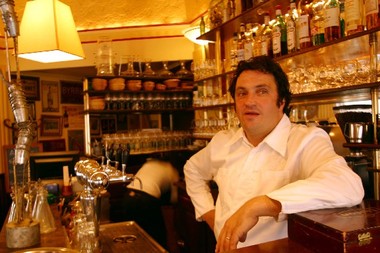Stars? We don’t need no stinkin’ stars
September 18, 2005 - Agence France Presse, The Globe and Mail, Expatica
There is no shortage of great chefs in France, but major shifts in the food scene here are few and far between. Nouvelle Cuisine lost its momentum about the same time “Miami Vice” went into reruns and, more recently, Spain has stolen more than a little haute cuisine thunder thanks to the culinary wizardry of experimentalist Ferran Adria.
But a gastronomic trend is bubbling to the surface in Paris, and the opening Monday of “Senderens”—the eponymous restaurant of Alain Senderens, who shocked the French culinary establishment in May by giving up his three Michelin stars—suggests that we may be witnessing more than a few isolated cases of top-tier kitchen fatigue.
 French Chef Yves Camdeborde poses in his bistro ‘Le Comptoir’ in Paris. There is no shortage of great chefs in France, but major shifts in the food scene here are few and far between. (AFP/File/Joe Ray)
French Chef Yves Camdeborde poses in his bistro ‘Le Comptoir’ in Paris. There is no shortage of great chefs in France, but major shifts in the food scene here are few and far between. (AFP/File/Joe Ray)Indeed, trading in the pressure of 300 euro-a-head haute cuisine for something simpler and more relaxed may just be the Next Big Thing.
There are only twenty-odd eateries in all of France that have earned the highest possible ranking from the all-powerful Michelin guide, and no chef has ever willingly relinquished that exalted status before Senderens, whose three-star streak lasted 28 years.
Known for the time being as “gastro bistros”—as in “gastronomic”—the new concept is simple: serve up Michelin star-worthy food at affordable prices and in a warm bistro atmosphere where one is not afraid to speak above a whisper.
The undisputed godfather of this incipient movement is Yves Camdeborde, a culinary maverick who looks a bit like a cross between Elvis and the French rocker “M”. Having made “La Regalade” one of the best upscale bistros in town, Camdeborde opened “Le Comptoir”—a second-generation gastro bistro—in the heart of the city in May.
Senderens took a much bigger leap in closing his temple of haute cuisine, Lucas Carton.
“I wanted to show that I had the will to renew, to turn the page,” he told AFP a couple days before the opening of “Senderens.” In a communique announcing the opening of his new establishment he talks of “freeing himself from the straight jacket of super luxury.”
“People want happy places,” says Camdeborde, explaining a shift he sees among diners who are moving away from the more austere Michelin-style places toward the more jovial bistros. “They should be able to laugh out loud.”
Though Camdeborde cites a key group of 12 chefs who are leading the charge, there are more. L’Express magazine recently came out with a list of the top 100 bistros in Paris under 30 euros and the gastro bistros are the darlings of the list.
Their chefs—who, like Camdeborde, were trained in the two- and three-star system—have opened tucked-away restaurants such as Chez Michel, Le Beurre Noisette and L’Os a Moelle.
One of the keys to success for these restaurants is the ‘prix fixe’ menu. Camdeborde and company tend to offer only a handful of choices, typically half-a-dozen each of appetizers, main courses and desserts.
The reduced menu helps keep costs down, and frequent—even daily—changes in the menu help keep customers coming back.
These more creative chefs are also eschewing the stale bistro classics like steak-and-chips, serving up fare on a par with that found in more traditional Michelin-starred restaurants.
Le Beurre Noisette chef Thierry Blanqui takes an extra long pause when asked about the goal of the movement. “We’re trying to democratize fine dining,” he finally says. “I’m convinced that we eat better with Camdeborde than we do with many starred chefs.”
Gastro bistro business tends to come by word of mouth, but the word is obviously out: upon reopening after the long summer holiday, for example, Beurre Noisette was completely booked for a week.
The folks at Michelin’s Red Guide do not seem to know quite what to make of the trend. It would not be the first time: the guide let Nouvelle Cuisine come and go without paying it much attention, and their reputation—largely intact despite a recent string of embarrassments—did not suffer as a consequence.
A Michelin spokesperson declined to respond to requests for a comment.
Here, however, the stakes may be higher. Though Nouvelle Cuisine did introduce a few lasting changes to French cooking, it had “trend” written all over it. Gastro bistros, however, work on making the best possible classic French cuisine, and some chefs have made their indifference to Michelin crystal clear.
Culinary superstar Joel Robuchon—who hung up his restaurant spurs in the late 1990s—went even further when he came out of retirement in 2003, explicitly asking the vaunted guide not to rate his new restaurants, two in Paris and another in Tokyo.
Camdeborde has an immense respect for the Red Guide, but he also thinks they may be missing the boat.
“I’m surprised they didn’t react a long time ago,” he says. “Major chefs are even telling them that it is time to change. Maybe they will.”